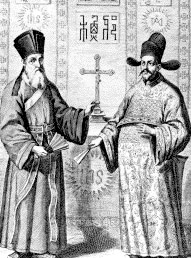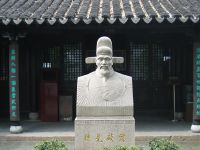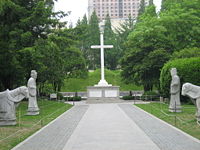Xu Guangqi
Xu Guangqi (Traditional Chinese: 徐光啟; Simplified Chinese: 徐光启; Hanyu Pinyin: Xú Guāngqǐ; Wade-Giles: Hsu Kuang-ch'i, 1562–1633), courtesy name Zixian (子先), was a Chinese bureaucrat, agricultural scientist, astronomer, and mathematician of the Ming Dynasty.
Life
Xu Guangqi was born in Shanghai, where his final resting place would be as well. Xu received the equivalent of his bachelor's degree at 19, but did not receive higher degrees until his thirties. Afterwards, he spent the majority of his time in positions of high office serving the Ming court.[1] He lived in a period when Chinese mathematics had gone into decline. The earlier efforts at algebra had been almost forgotten. Xu blamed some of the failures on a decline in interest of practical science in China and became something of a critic of Chinese society.
He was a colleague and collaborator of Matteo Ricci, the Italian Jesuit. Together they translated several classic Western texts (most notably part of Euclid's Elements) into Chinese, as well as several Chinese Confucian texts into Latin.[2] Ricci's influence led to Xu being baptized as a Roman Catholic in 1603, under the name "Paul Xu Guangqi".[2] After this his criticism of Chinese intellectual life became harsher and he came to deem China to be inferior to the West,[citation needed] specifically in mathematics. He also believed that adopting Western military armaments and artillery would save them from the Manchu, but this idea failed after the Manchu themselves learned to make European cannons.[1] His descendants remained staunchly Catholic into the nineteenth century.
From 1607 until 1610, Xu was forced to retire from public office, and returned to his home in Shanghai. It was during this time that he experimented with Western-style irrigation methods.[1] He also experimented with the cultivation of sweet potatoes, cotton, and the nu zhen tree.[1] He was called once more to serve the Chinese bureaucracy, where he rose to a high rank and became known late in his career simply as "The Minister".[2] Yet he continued to experiment and learn of new agricultural practices while he served his office, promoting the use of wet-rice in the Northeast of China.[1] From 1613 until 1620 he often visited Tianjin, where he helped organize self-sufficient military settlements (tun tian).[1]
Xu Guangqi's tomb still exists in Shanghai in Guangqi Park just a short walk from the Xujiahui Cathedral in the Xujiahui area on Nandan Road (南丹路).
Work

Mathematics
In 1607, Xu and Ricci translated the first parts of Euclid's Elements into Chinese, introducing his countrymen to new concepts in mathematics and Western logic. Chinese scholars credit Xu as having "started China's enlightenment".[2]
Astronomy
After followers of Xu and Ricci publicly predicted a solar eclipse in 1629, Xu was appointed by the Emperor as the leader of an effort to reform the Chinese calendar. The reform, which constituted the first major collaboration between scientists from Europe and from the Far East, was completed after his death.[2]
Agriculture
Xu Guangqi wrote the Nong Zheng Quan Shu, an outstanding agricultural treatise that followed in the tradition of those such as Wang Zhen (wrote the Wang Zhen Nong Shu of 1313 C.E.) and Jia Sixia (wrote the Chi Min Yao Shu of 535 C.E.).[3] Like Wang Zhen, Xu lived in troubled times, and was devoted as a patriot to aiding the rural farmers of China.[1] His main interests were in irrigation, fertilizers, famine relief, economic crops, and empirical observation with early notions of chemistry.[1] It was an enormous written work, some 700,000 written Chinese characters, making it 7 times as large as the work of both Jia Sixia and Wang Zhen.[4] Although its final draft was unfinished by Xu Guangqi by the time of his death in 1633, the famous Jiangnan scholar Chen Zilung assembled a group of scholars to edit the draft, publishing it in 1639.[4]
The topics covered by his book are as follows:[4]
- The Fundamentals of Agriculture (Nong Ben): quotations from the classics on the importance of encouraging agriculture
- Field System (Tian Zhi): land distribution, field management
- Agricultural Tasks (Nong Shi): clearing land, tilling; also a detailed exposition on settlement schemes
- Water Control (Shui Li): various methods of irrigation, types of irrigation equipment, and the last two chapters devoted to new Western-style irrigation equipment
- Illustrated Treatise on Agricultural Implements (Nong Chi Tu Pu): based largely on Wang Zhen's book of 1313 C.E.
- Horticulture (Shi Yi): vegetables and fruit
- Sericulture (Can Sang): silk production
- Further Textile Crops (Can Sang Guang Lei): cotton, hemp, etc.
- Silviculture (Chong Chi): forestry preservation
- Animal Husbandry (Mu Yang)
- Culinary Preparations (Zhi Zao)
- Famine Control (Huang Zheng): administrative measures, famine flora
Notes
| This article contains Chinese text. Without proper rendering support, you may see question marks, boxes, or other symbols instead of Chinese characters. |
ReferencesISBN links support NWE through referral fees
- Needham, Joseph (1986). Science and Civilization in China: Volume 3, Mathematics and the Sciences of the Heavens and the Earth. Taipei: Caves Books, Ltd.
- Needham, Joseph (1986). Science and Civilization in China: Volume 6, Biology and Biological Technology, Part 2: Agriculture. Taipei: Caves Books, Ltd.
- Zhao, Jikai, "Xu Guangqi". Encyclopedia of China (Economics Edition), 1st ed.
- Mei, Rongzhao, "Xue Guangqi". Encyclopedia of China (Mathematics Edition), 1st ed.
- Stone, Richard (2007). "Scientists Fete China's Supreme Polymath," Science 318, 733.
See also
- List of Chinese people
- List of mathematicians
- History of agriculture
External links
- McTudor
- Ricci Roundtable at the University of San Francisco
- University of Texas article mentioning him
- Xu Guangqi at the University of Maine
Credits
New World Encyclopedia writers and editors rewrote and completed the Wikipedia article in accordance with New World Encyclopedia standards. This article abides by terms of the Creative Commons CC-by-sa 3.0 License (CC-by-sa), which may be used and disseminated with proper attribution. Credit is due under the terms of this license that can reference both the New World Encyclopedia contributors and the selfless volunteer contributors of the Wikimedia Foundation. To cite this article click here for a list of acceptable citing formats.The history of earlier contributions by wikipedians is accessible to researchers here:
The history of this article since it was imported to New World Encyclopedia:
Note: Some restrictions may apply to use of individual images which are separately licensed.


